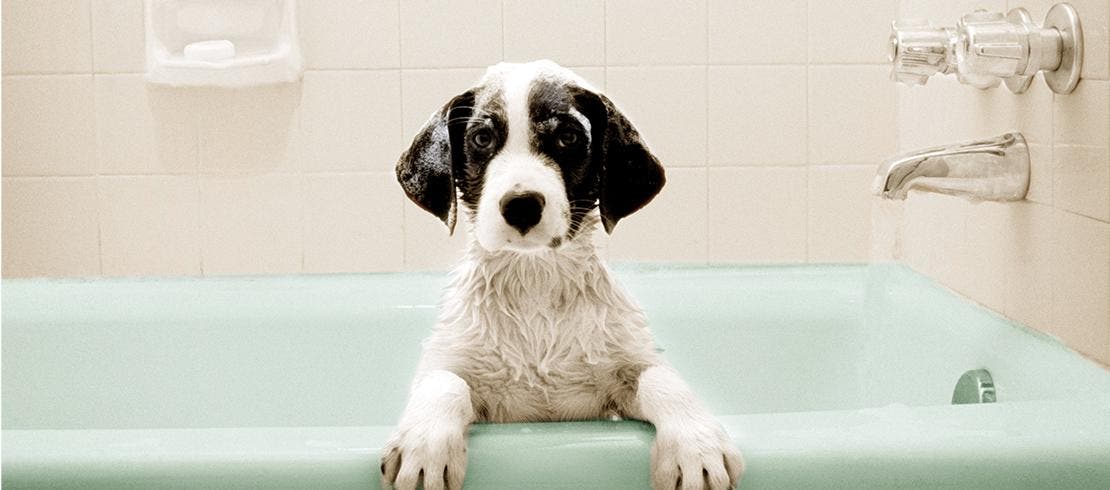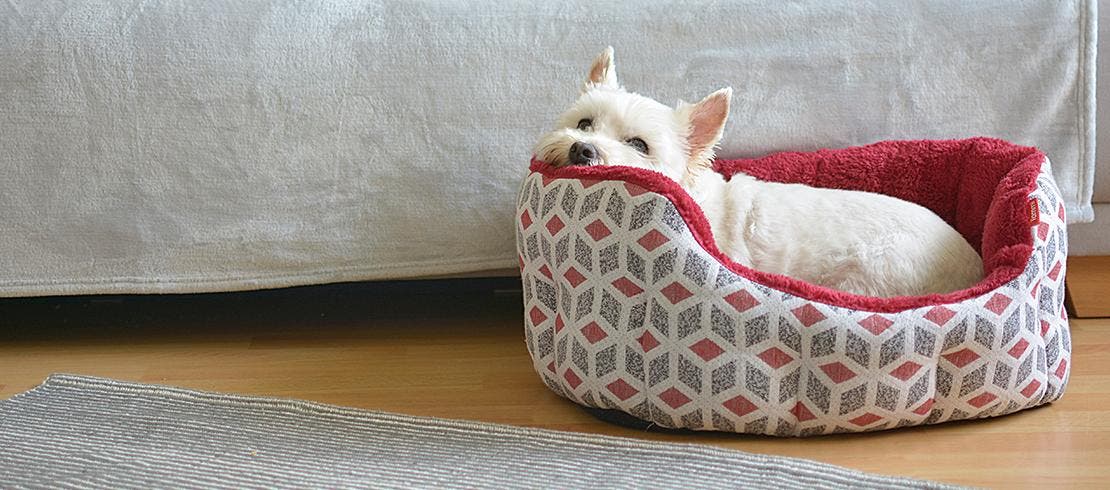Fleas don't care how old your dog is before they start biting. These nasty parasites feed on the blood of dogs and cats and their bites quickly cause discomfort, prompting scratching which can lead to infection.
Fleas on puppies can be more serious than on adult dogs, so it’s extra important to use a puppy flea treatment to get rid of fleas and prevent an infestation of your pets and home.
There are a number of ways to deal with fleas on puppies once they’ve taken hold, but it’s important to know what you’re doing. A pet owner who uses flea products on an animal that is too young could cause them harm. Stick to the rules, know what you’re up against, and your puppy can be effectively protected against fleas.

Step 1: Treating your puppy for fleas
Puppies eight weeks of age and younger
Choose a treatment specifically for young puppies
You’ll know when to use a flea treatment on your puppy because it will coincide with them venturing outside for the first time – usually from two months of age. Puppies aren’t usually at risk of catching fleas until they step into the great outdoors.
But, if you have to treat your puppy before they’re eight weeks old, you should choose a treatment that is designed for young puppies. This is because adult flea treatments are unsuitable and could be harmful to a puppy.
Always check the label for which ages a product is designed for and how often the treatment should be applied and if you’re unsure, speak to your vet for advice.

Use a flea comb to spot fleas and help remove them
Try to make flea combing part of your regular routine – it’s great for puppy bonding too! These specialist combs have tightly packed teeth that physically pull fleas out of the fur.
Comb one section at a time, parting your pup’s fur to get as close to the skin as possible. Start at the neck and work your way across the whole body.
Fleas can be tricky to spot since they are very small – just a few mm long – and have flat bodies, which help them easily slide between strands of fur. While their dark-coloured bodies (brown or reddish brown) are well camouflaged in dark hair.
You may also come across tiny black flecks, which look a bit like ground pepper. This is ‘flea dirt’, the name for flea faeces. It can help to place a piece of white paper under your pet when using the flea comb to make it easier to see the fleas and flea dirt you’re uncovering.
If you find a flea, it’s important to kill it before it finds its way back to your pet. You can do this by simply dropping it into a bowl of soapy water. You should then speak to your vet as soon as possible about suitable flea treatments for puppies.

Look out for any signs of fleas
Fleas can affect human health and pet health, as they will happily bite both, so you’ll need to be thorough. Even if your flea comb doesn’t result in any evidence of fleas, it’s important to look out for any symptoms of flea bites in your puppy.
Scratching is one of the most common symptoms as a flea bite can be itchy and uncomfortable. Excessive scratching can lead to red, irritated skin and risk of infection.
Other signs in puppies include restlessness, licking and biting at certain areas on the body and, in more extreme cases, a flea infestation can lead to dehydration and anaemia since puppies are smaller than adult dogs. This can appear as weight loss, lethargy and pale gums.
Flea treatment for older puppies – over eight weeks of age
Puppies aged eight weeks and older can often be treated with standard flea control products. There are several different options including spot-ons, tablets and collars.
Advantage spot-on is suitable for pets from eight weeks. It kills fleas within 24 hours and is effective for up to four weeks.
Seresto Flea and Tick Control collar can actually be used on puppies aged seven weeks and older. It is able to kill fleas and ticks through contact without the need for them to bite.1 The collar helps protect your dog or cat against fleas and ticks for up to eight months in a single application. When using any product always carefully read the instructions to check it is safe to use on your puppy.
Find out more about Seresto Flea and Tick Control collar.
The most suitable treatment for your puppy will depend on their lifestyle, how old they are and how much they weigh. Speak to your vet if you’re unsure which flea treatment to use on your puppy.
Step 2: Treating the mother for fleas
If your puppy has fleas, you should treat all pets that live in the same home to prevent re-infestation. This includes their mother because if any puppies in the litter have fleas, it’s almost certain that the mother will have them too.
If the mother is still producing milk for her puppies, it’s important to use a flea product that is specifically designed for lactating mothers. This is because the treatment can pass to the puppies through the milk and certain flea treatment ingredients may not be safe for young puppies. Always speak to your vet if you are unsure about which product is suitable.

Step 3: Keeping your house clean and flea-free
Female fleas can lay up to 50 eggs a day and start laying just 24 to 36 hours after their first blood meal. In fact, 95 per cent of the flea population in a home will be made up from eggs, larvae and pupae, with just five percent comprising adult fleas.
These eggs will be carried on your pet, and fall off into the home in places where your puppy loves to spend time such as on soft furnishings, in carpets and on upholstery.
Wash your puppy's bedding
Any soft bedding, blankets, throws, upholstery or rugs should be put on a hot wash at 60ºC and, if possible, tumble-dried for at least 30 minutes. Similarly, pet carriers and your pup’s favourite resting places should be thoroughly cleaned and disinfected to remove flea eggs and larvae.

Vacuum regularly
Vacuuming can kill more than 90 per cent of adult fleas and also help remove flea eggs and larvae.2 If you plan to use an insecticide spray, vacuuming helps by causing pupae to hatch bringing the new fleas to the surface of the carpet so they can be more easily reached by spray or powder treatments.
Use a household flea spray
Speak to your vet about a recommended environmental spray that you can use around your home to kill fleas living in the carpets or other soft furnishings. Make sure you read the instructions carefully and remove pets and children from the room before using. Afterwards, air out the room for a few hours, opening the windows and doors if possible.
Did you know…?
Fleas reverse direction every time they jump. That's like taking every second step backwards – an excellent way to get very dizzy!
- Mehlhorn et al. Parasitol Res (2001) 87:198-207, information is regarding mode of action and is not intended to relate to speed of kill or to imply parasites can be completely stopped from biting. An attachment of single ticks after treatment cannot be excluded; for this reason, a transmission of infectious diseases cannot be completely excluded if conditions are unfavourable.
- Science Daily, Cat Fleas’ Journey into the Vacuum is a ‘One-way Trip’: https://www.sciencedaily.com/releases/2007/12/071217111010.htm. Accessed August 2019
